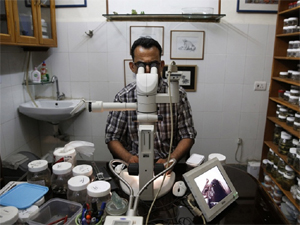



Date:02/04/16
 Bio-engineered skin complete with functioning hair follicles, glands and nerves has been grown using a new technique which could transform burns treatment and end cosmetics testing on animals.
Bio-engineered skin complete with functioning hair follicles, glands and nerves has been grown using a new technique which could transform burns treatment and end cosmetics testing on animals.
Working with mice, scientists in Japan created the skin by first producing three-dimensional clumps of cells that resembled embryos in the womb.
They then implanted the so-called "embryoid bodies" (EBs) into immune-deficient mice, where the cells developed further. Next, the maturing cells were grafted onto the bodies of other mice to complete their transformation into skin.
The end result was functional "integumentary tissue", the deeply layered tissue that allows the skin to work as the body's largest organ.
Lead scientist Dr Takashi Tsuji, from the RIKEN Centre for Developmental Biology, said: "Up until now, artificial skin development has been hampered by the fact that the skin lacked the important organs, such as hair follicles and exocrine glands, which allow the skin to play its important role in regulation.
"With this new technique, we have successfully grown skin that replicates the function of normal tissue.
"We are coming ever closer to the dream of being able to recreate actual organs in the lab for transplantation, and also believe that tissue grown through this method could be used as an alternative to animal testing of chemicals."
At the start of the study, cells taken from the gums of mice were turned into induced pluripotent stem (iPS) cells by exposing them to a cocktail of chemicals that turned back their developmental clock. These were then coaxed to develop into EBs in the laboratory.
Previous attempts at growing skin from stem cells have only got as far as producing implantable sheets of epithelial cells, which formed the outermost skin layer but lacked functional elements such as oil-secreting sebaceous and sweat glands.
The skin produced by Dr Tsuji's team made normal connections with surrounding nerve and muscle tissue and sprouted hair.
The research, reported in the journal Science Advances, brings effective regenerative treatments for patients with severe burns and skin diseases a significant step closer.
It could also provide an alternative to testing cosmetics and household products, such as detergents, on animals.
Lab-grown skin could 'cure' baldness and provide burns treatment breakthrough
 Bio-engineered skin complete with functioning hair follicles, glands and nerves has been grown using a new technique which could transform burns treatment and end cosmetics testing on animals.
Bio-engineered skin complete with functioning hair follicles, glands and nerves has been grown using a new technique which could transform burns treatment and end cosmetics testing on animals.Working with mice, scientists in Japan created the skin by first producing three-dimensional clumps of cells that resembled embryos in the womb.
They then implanted the so-called "embryoid bodies" (EBs) into immune-deficient mice, where the cells developed further. Next, the maturing cells were grafted onto the bodies of other mice to complete their transformation into skin.
The end result was functional "integumentary tissue", the deeply layered tissue that allows the skin to work as the body's largest organ.
Lead scientist Dr Takashi Tsuji, from the RIKEN Centre for Developmental Biology, said: "Up until now, artificial skin development has been hampered by the fact that the skin lacked the important organs, such as hair follicles and exocrine glands, which allow the skin to play its important role in regulation.
"With this new technique, we have successfully grown skin that replicates the function of normal tissue.
"We are coming ever closer to the dream of being able to recreate actual organs in the lab for transplantation, and also believe that tissue grown through this method could be used as an alternative to animal testing of chemicals."
At the start of the study, cells taken from the gums of mice were turned into induced pluripotent stem (iPS) cells by exposing them to a cocktail of chemicals that turned back their developmental clock. These were then coaxed to develop into EBs in the laboratory.
Previous attempts at growing skin from stem cells have only got as far as producing implantable sheets of epithelial cells, which formed the outermost skin layer but lacked functional elements such as oil-secreting sebaceous and sweat glands.
The skin produced by Dr Tsuji's team made normal connections with surrounding nerve and muscle tissue and sprouted hair.
The research, reported in the journal Science Advances, brings effective regenerative treatments for patients with severe burns and skin diseases a significant step closer.
It could also provide an alternative to testing cosmetics and household products, such as detergents, on animals.
Views: 479
©ictnews.az. All rights reserved.Similar news
- Azerbaijani project to monitor disease via mobile phones
- Innovative educational system to be improved under presidential decree
- NTRC prolongs license of two TV and radio organizations for 6 years
- Azerbaijan establishes e-registry for medicines
- Azerbaijani museum introduces e-guide
- Nar Mobile opens “Nar Dunyasi” sales and service center in Siyazan city
- International conference on custom electronic services held in Baku
- OIC secretary general to attend COMSTECH meeting in Baku
- Azerbaijan develops earthquake warning system
- New law to regulate transition to digital broadcasting in Azerbaijan
- Azerbaijani State Social Protection Fund introduces electronic digital signature
- Intellectual traffic management system in Baku to be commissioned in December
- Tax Ministry of Azerbaijan started receiving video-addresses
- World Bank recommends Azerbaijan to speed up e-service introduction in real estate
- Azerbaijan to shift to electronic registration of real estate





















